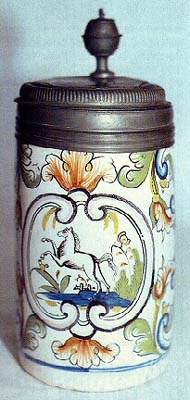
by Jack G. Lowenstein
When beautifully decorated Chinese porcelain wares reached the European continent in the 15th and 16th centuries, the European potters were intent on copying this amazing material in order to protect their markets. But for a time (until the 18th century), the mystery of porcelain was beyond them, and the best they could do was to duplicate the decor and art work on glazed earthenware bodies. But since earthenware was too porous to adequately “hold” the colored decorations, a new surface glaze was required.
 |
It did not take long for the decorators and artists to experiment on this new material and by the end of the 15th century, beautifully decorated wares appeared, multi-colored, with both original, fanciful designs and motifs copied from the Chinese “export wares.” Since much unpainted faience was shipped to other European countries, a small cottage industry sprang up, with talented artists “custom decorating” Italian wares for local customers.
Quite soon, however, the potters in Germany, Austria, France, Holland and England discovered for themselves how to make tin-glazed pottery, and soon the material spread all over Europe, where it became the ceramic of choice for the rich and well-to-do. After all, it was the closest thing to the still very expensive Chinese porcelain. It looked good, it was quite utilitarian, and it cost less than porcelain. Faience factories started up in dozens of faience centers, such as Ansbach, Braunschweig, Erfurt, Schrezhein, Nuremberg, Hanau, Delft, and on and on. Each such center developed its own techniques and consequently it is possible to identify and place an unmarked faience tankard, for instance, by its shape and decoration style.
While most of the faience wares were decorated by the potters or their apprentices, many continued to be decorated by “Hausmaler,” (i.e., home artists) who literally worked out of their homes, custom decorating blank bodies supplied by the potters. Articles decorated by Hausmaler are very collectible and are eagerly sought by sophisticated collectors.
Fate stepped in to just about destroy the faience industry early in the 18th century, when porcelain was discovered (or re-discovered) in Dresden, Germany, by Johann Friedrich Boettger. Since the new European porcelain was more delicate and more durable than faience and could be shaped into more intricate forms, it soon displaced glazed earthenware. Except for some holdouts, faience manufacturing ended in the 18th century, but for about 300 years it was the ceramic of choice in Europe. It set the stage for future developments and set the standard for fine decorations.
Antique faience (or majolica or Delft-ware) is highly collectible today, but pieces in good condition are very expensive. Because earthenware is extremely fragile, many faience pieces have been lost, and much of what remains is chipped or cracked, or the surface decorations have worn off. Beginning in the second half of the 19th century, old faience was being reproduced widely and some excellent copies were made. The collector has to be very careful — and knowledgeable — to distinguish between the “new” and the authentically old. Novices and even experienced collectors are sometimes fooled.
__________
*Reprinted by permission from All About Beer Magazine, Vol. 13, No. 2, May 1992.